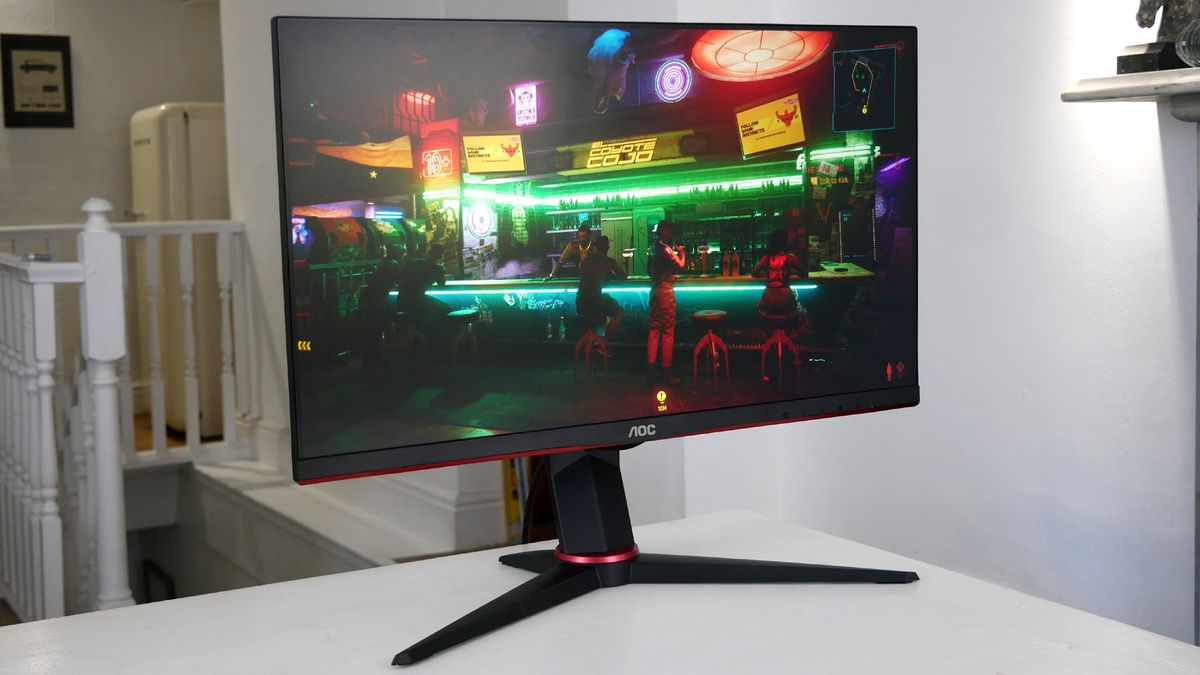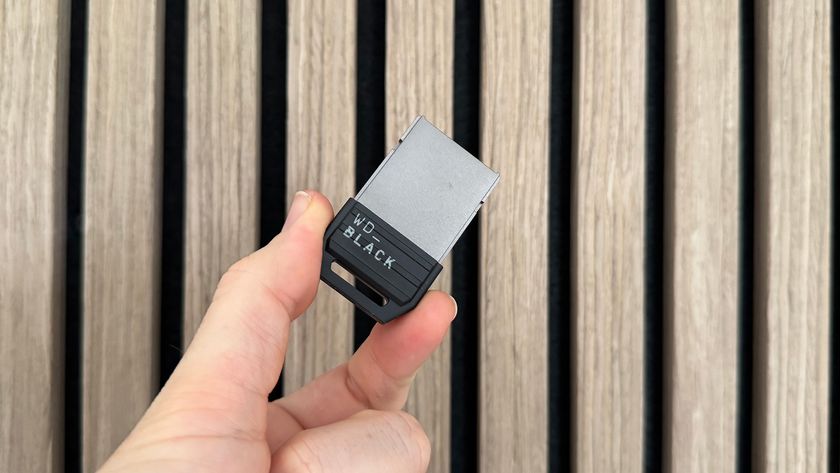12DOVE Verdict
High refresh 1080p gaming at a price you can afford.
Pros
- +
Good all-round image quality
- +
Really quick response
- +
Seriously competitive pricing
Cons
- -
‘Only’ 1080p resolution
- -
No HDR support
Why you can trust 12DOVE
The AOC 24G2 - also known in some markets as the AOC 24G2U - is that rarest of things in these unusual times: a gaming peripheral that won’t break the bank.
It’s a 24-inch gaming monitor typically available for around $180 in the US (though it's currently a bit higher than that) and for just £150 in the UK. For that you get all your basic gaming needs covered. And then some. High refresh, IPS image quality, adaptive sync, even slim-bezel styling, it’s all there - all the makings of a 1080p contender for best gaming monitor.
Inevitably at this price point something has to give. Along with the modest 24-inch proportions, you’ll also have to make do with that 1080p resolution. But then that’s a good fit with both the performance of most budget-orientated gaming PCs and, you know, the average gamer’s actual budget, be that PC or console gaming.
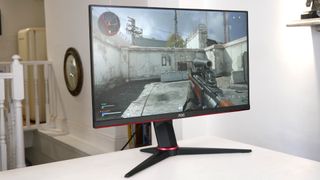
Design & Features
At the heart of the AOC 24G2 is a 24-inch IPS LCD panel. That bodes well for basic image quality, including colours, viewing angles, and pixel response. Native resolution is a modest 1,920 by 1,080 pixels. But that’s a given at this end of the market and also makes for a good fit with affordable graphics cards; higher resolutions put more load on a PC’s graphics subsystem.
It likewise means that you won’t need a thousand-dollar best graphics card model to take advantage of the AOC 24G2’s 144Hz refresh rate. As for pixel response, the panel is officially rated at 1ms by the MPRT metric and 4ms by the more demanding grey-to-grey measure. It’s nice to see a monitor manufacturer quote both response standards. Neither is a totally reliable guide to real-world performance, but more information is always better. Anyway, this is therefore a quick gaming panel, but it’s not at the very cutting edge of IPS technology, which currently clocks in at 0.5ms MPRT and 1ms GtG.
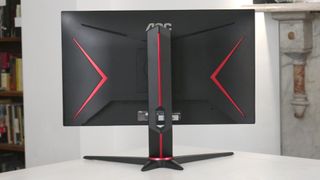
Elsewhere, adaptive refresh takes the form of AMD FreeSync premium certification but there’s no HDR support at all. The latter omission isn’t much of an issue, in practice. Vanishingly few monitors that claim HDR capability actually deliver. None do so anywhere even close to the AOC 24G2’s price. For the record, AOC pegs the panel’s colour accuracy at 91 percent coverage of the Adobe RGB colour space, which is adequate but nothing special, especially for an IPS monitor.
As for inputs, a pair of HDMI ports plus DisplayPort and even a VGA connector make this a widely compatible contender and a decent fit for both PC gaming as well as being a PS5 monitor or Xbox Series X monitor.
There is one slight distinction to raise between the 24G2U and the 24G2 here: the 24G2U sports a quad-port USB hub, but the 24G2 version does not. Something common to both models is fairly slick slim-bezel design and, mostly impressively, a fully adjustable stand that even supports rotation into portrait mode. Nice.
Performance
If you’re looking for a hugely punchy gaming panel, the AOC 24G2 isn’t it. But the basic image quality is decent. It looks like an IPS panel for all the right reasons, with reasonably vibrant and accurate colours and decent factory calibration. There’s only a little compression in darker tones visible in test images.
More importantly, it’s quick. Not quite as quick as the very best 1ms IPS screens, but really not far off from a subjective perspective. AOC has included three levels of pixel-accelerating overdrive in the OSD menu and even the fastest doesn’t result in any clearly visible overshoot. That means you can actually use this panel in its fastest mode without any obvious downsides.
The 144Hz refresh will likewise be plenty for most gamers in terms of perceived latency and input lag. You probably want something a bit quicker if you aspire to tournament-level esports. But for everyone else, the AOC 24G2 should keep you competitive enough.
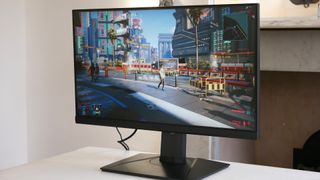
Of course, with relatively modest brightness and lack of HDR support, not to mention the mere 1080p native resolution, the sheer visual spectacle on offer isn’t all that memorable. So, the AOC 24G2 is at its best knocking out the frames in games like Fortnite and Apex Legends rather than attempting a forensic inspection of the impact of ray-tracing in Crysis Remastered.
But there’s also adequate inherent image quality to provide a decent experience in pretty much any gaming scenario, including on console. Indeed, if you’re looking for an affordable entry into 120Hz (at 1080p) console gaming, you could do a whole lot worse.
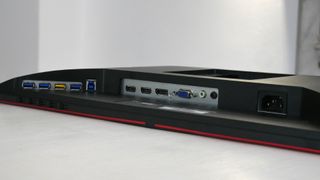
Overall - should you buy it?
The AOC 24G2 doesn’t break any records or set new standards; the basic package of a 24-inch IPS panel with 144Hz refresh and 1080p native resolution isn’t radical. But at this price point, it does make for a pretty appealing all-purpose gaming package.
That’s particularly true given that the AOC 24G2 doesn’t suffer from any obvious flaws. Indeed, if anything the subjective experience in terms of panel speed is better than the 4ms GtG performance claims. Add in the slim-bezel design and decent feature set, including a fully adjustable stand and a good array of inputs, and you have a very competitive overall proposition for the price.
And don't forget: it's nearly that time of year again so prepare for the Black Friday gaming monitor deals in a couple of months time.
A serious dissertation on the finer points of input lag and overshoot followed by a forensic examination of AI-accelerated temporal upscaling. Such is a routine day in the working life of long-time tech wordsmith, Jeremy Laird. Along with GamesRadar, Jeremy’s 15-year back catalogue includes a host of tech and gaming outlets, including TechRadar and PC Gamer, not to mention contributions to mainstream media from the Independent to the Evening Standard. Complimenting Jeremy’s debilitating addiction to all kinds of digital hardware, he is also afflicted by an obsession with and a significant occupational sideline in cars and automotive technology.

Ex Nintendo PR managers say the Switch 2 generation is likely to see the retirement of "several of the major developers at Nintendo who we have known for 40 something years"

Helldivers 2 CEO says industry layoffs have seen "very little accountability" from executives who "let go of one third of the company because you made stupid decisions"

Spider-Man: Brand New Day - How Peter Parker and Mary Jane's break up led to one of the wall-crawler's most transformative comic eras
